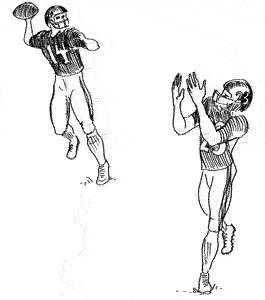STRANGE BUT TRUE- One down: Quarterback needs schooling
Published January 19, 2005 in issue 0503 of the Hook
BY BILL SONES AND RICH SONES, PH.D. [email protected]

DRAWING BY DEBORAH DERR McCLINTOCK
Q. Did this guy need to go back to quarterback school, or what? He threw the football well, but on rollout passes would always lead the receiver too much, the ball dropping beyond outstretched arms. What was going wrong? --J. Unitis
A. It was back in the days of Ohio State's Woody Hayes, and a scientist friend of the great coach had an idea: Maybe the QB's problem had to do with his failure to understand what physicists call "moving frames of reference," said Case Western Reserve University's John D. McGervey.
When you're riding in a car and toss a ball to another passenger, you just throw it directly at the person because you're both in the "same moving frame of reference." But try to toss the ball to someone out on the sidewalk, and that's a different matter.
The point was that maybe the QB didn't understand that with rollout passes where he and the receiver are running stride for stride, he should throw the ball right at the receiver, as if the two of them were stationary. Leading the receiver is necessary only when the QB is stationary and the receiver is moving.
Right on target! Problem solved. Quarterback school dismissed.
Q. For the Human Genome Project (1990-2003), whose genome was chosen as scientific exemplar of Homo sapiens, with our 20,000-25,000 genes? a) an illustrious dignitary b) a random "nobody" pulled off the street c) a child d) Mr/Ms Average e) an anonymous clone of cells from a tissue culture lab? --D. Fossey
A. It certainly makes a difference since some of us have brown eyes while others have blue, some of us can't curl our tongue into a tube whereas it's 50-50 that you can, and so on, says Richard Dawkins in The Ancestor's Tale. Yes, we can trace "our ancestors" back through time, "but whose ancestors are we talking about: yours or mine, a Bambuti Pygmy's, or a Torres Strait Islander's?"
In the "official" project, for the very small fraction of genes that vary from person to person, the canonical genome is the majority "vote" among a couple of hundred people chosen to represent racial diversity. So the answer above is d), though a bit more abstract and statistical than just some Mr or Ms Average-- rather scores of them combined.
Bear in mind, says Dawkins, that we don't need to trace very far back along the human "tree" to find that "all your ancestors are mine, whoever you are, and all mine are yours... everybody's ancestors are shared."
Q. Apple-aficionados, would you like a Fuji, a Granny Smith, a Jonagold, a Susan Brown...? A Susan Brown? How many varieties are there today for the picking? --J. Appleseed
A. At the USDA-Agricultural Research Service's Plant Genetics Resources Unit in Geneva, New York, are DNA samples of over 3,000 apple varieties from all over the world, kept in pairs just like the original ark of diversity, reports Philip Forsline of Cornell University.
Storage of germplasm is an important new bulwark against pests and pathogens that might threaten the global food supply.
"At Cornell," says horticultural scientist Susan Brown, "we have bred varieties such as Empire, Jonagold, Cortland, and Macoun, and are developing new hybrids. Some apples now have new flavors (hints of anise or banana), textures, shapes, appearance. We tried to create some that kids will want to eat as much as snack foods and can create varieties with as much vitamin C as an orange, or that don't discolor when you cut them.
"But without a doubt no new apple will bear my name because the 'Brown apple' just doesn't have that marketing ring to it :)."
Q. As a rule, things you have to work hard for are more appreciated. So naturally potential dates who play "hard to get" are the ones everybody works hardest to get. True or false? --P. Hilton
A. Sounds reasonable enough, but it's wrong, say romance researchers. Sure, everybody wants a rich movie star, but what nobody wants is to make a pitch and hear back, "Get lost, creep!"
In other words, daters don't want to put their fragile hearts and souls out on the chopping block. The bottom line, says Michael R. Liebowitz in The Chemistry of Love, is that men (the subjects studied) prefer women who are hard to attract more than women who are easy to attract, but only if it's not hard for them.
Doesn't it just figure?
Send Strange questions to brothers Bill and Rich at [email protected].
#
|